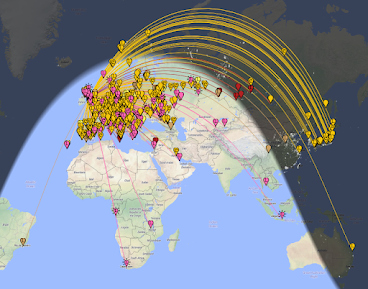IT SEEMS A WELL-HIDDEN NOTE ABOUT COVID INFECTION AMONGST OPERATORS ON THE ALEXANDER ASSOCIATION WEBSITE MEANS THIS EVENT WAS CANCELLED AS OF THIS MORNING.
As someone who's written a book about a Marconi VLF station, it's a bit odd that I have always somehow failed to listen-out for the last-remaining, working Alexanderson alternator VLF transmissions from UNESCO World Heritage site, SAQ at Varberg, Sweden.
This is all the more odd, because Karl-Arne Markström, retired Systems Engineer for Swedish Telecom Radio, owner of the SAQ site until 1997, wrote the foreword for my book!
During the year, to
help support the continued operation of SAQ, I joined the Alexander
Association, which is something I would encourage you to do, too -
it's just 12 Euro! This meant I got an email recently, announcing
that SAQ, after a period of non-operation due to parts problems,
would fire-up and transmit again on 24/12/2022. The event will be livestreamed on You Tube.
 |
| This rapidly-spinning disc of high-tensile, toothed steel will transmit at 17.2kHz on Christmas Eve. Image: Alexander Association. |
The usual mad rush to equip myself for the event then ensued. After some discussion on Mastodon, I was directed towards a passive loop antenna, which I built. This works fine, receiving the German DCF-77 time signal at 15kW quite clearly, with strong directionality.
 |
|
My first VLF, passive loop. Works OK, but can be improved upon. |
 |
| Schematic for the 'YouLoop'-type, passive antenna. |
I was also told about the Wellgood (not Wellbrook) loop and bias-tee boards, to which one simply adds any description of a roughly 3m circumeference loop; I used RG213, utilising the braid only.
For £44, delivered, the Wellgood seemed like very good value, next to Wellbrook's latest loop antenna, which comes in at £264.
I used a couple of small IP66 boxes to enclose the boards; a couple of holes for wires and sockets need to be drilled and widened using a reamer.
 |
| The loop board, in its IP66 enclosure. Ideally, it should be higher, to allow water to drip off the wires, rather than run into the box. |
The bias tee needs a quiet 12V supply, so something like a linear PSU or battery (there is only a ~120mW draw) is ideal. For portable use, I attached the bias tee box to the stem of the loop, but for permanent outdoor use, the tee is best located indoors.
 |
| The bias-tee board mounted in its box. |
For reception, I tried my trusty SDRPlay RSP1a. All connected-up, this proved to be a huge success! Signals at VLF are simply astounding - with a loop merely 1m across! You can switch to any band you like, without any need for tuning and, voila! Strong signals on all of them!
There's clearly no doubt that SAQ, putting out around 80kW of its maximum 200kW, should be easily and strongly detected on the 24th. But I will have both the passive loop and short Beverege antennas up as standbys and for comparisons.
Here's how it receives, from within my house, DCF-77 and MSF time signals in Germany and the UK, respectively. There's also some long-wave commercial signals from Ireland (252kHz) and BBC Radio 4 (198kHz) at the end:
Whilst I was beign excited over on Mastodon about this antenna system, someone piped-up an opinion that, but for digital signals, these antennas were of no use; we perceive them as useful, he said, because of the amazing abilities of digimodes to pull signals "from the noise". I opted-out of this pointless, wrong and very tired discussion, and instead went to prove it as such with some examples.
Here's a quick look at 14MHz SSB. Clearly not the proverbial "dummy load" claimed by my Mastodon acquaintance (now blocked):
And if FT8 is more
your thing, this is how a few minutes on 20-10m turned-out on
receive this morning (terminator correct for period):


No comments:
Post a Comment